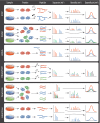A Biologist's Field Guide to Multiplexed Quantitative Proteomics
- PMID: 26873251
- PMCID: PMC4858934
- DOI: 10.1074/mcp.O115.056986
A Biologist's Field Guide to Multiplexed Quantitative Proteomics
Abstract
High-throughput genomic and proteomic studies have generated near-comprehensive catalogs of biological constituents within many model systems. Nevertheless, static catalogs are often insufficient to fully describe the dynamic processes that drive biology. Quantitative proteomic techniques address this need by providing insight into closely related biological states such as the stages of a therapeutic response or cellular differentiation. The maturation of quantitative proteomics in recent years has brought about a variety of technologies, each with their own strengths and weaknesses. It can be difficult for those unfamiliar with this evolving landscape to match the experiment at hand with the best tool for the job. Here, we outline quantitative methods for proteomic mass spectrometry and discuss their benefits and weaknesses from the perspective of the biologist aiming to generate meaningful data and address mechanistic questions.
© 2016 by The American Society for Biochemistry and Molecular Biology, Inc.
Conflict of interest statement
The authors declare that they have no conflicts of interest with the contents of this article.
Figures

Similar articles
-
Bioinformatics Resources for Interpreting Proteomics Mass Spectrometry Data.Methods Mol Biol. 2017;1647:267-295. doi: 10.1007/978-1-4939-7201-2_19. Methods Mol Biol. 2017. PMID: 28809010
-
Emerging Proteomic Technologies Provide Enormous and Underutilized Potential for Brain Cancer Research.Mol Cell Proteomics. 2016 Feb;15(2):362-7. doi: 10.1074/mcp.R115.053884. Epub 2015 Sep 25. Mol Cell Proteomics. 2016. PMID: 26407994 Free PMC article. Review.
-
Single-platform 'multi-omic' profiling: unified mass spectrometry and computational workflows for integrative proteomics-metabolomics analysis.Mol Omics. 2018 Oct 8;14(5):307-319. doi: 10.1039/c8mo00136g. Mol Omics. 2018. PMID: 30211418 Review.
-
Data management in mass spectrometry-based proteomics.Methods Mol Biol. 2011;728:321-32. doi: 10.1007/978-1-61779-068-3_21. Methods Mol Biol. 2011. PMID: 21468958
-
Trans-proteomic pipeline: a pipeline for proteomic analysis.Methods Mol Biol. 2010;604:213-38. doi: 10.1007/978-1-60761-444-9_15. Methods Mol Biol. 2010. PMID: 20013374
Cited by
-
Proposing a minimal set of metrics and methods to predict probabilities of amyloidosis disease and onset age in individuals.Aging (Albany NY). 2020 Nov 18;12(22):22356-22369. doi: 10.18632/aging.202208. Epub 2020 Nov 18. Aging (Albany NY). 2020. PMID: 33203794 Free PMC article.
-
Noise Exposures Causing Hearing Loss Generate Proteotoxic Stress and Activate the Proteostasis Network.Cell Rep. 2020 Nov 24;33(8):108431. doi: 10.1016/j.celrep.2020.108431. Cell Rep. 2020. PMID: 33238128 Free PMC article.
-
Advanced Overview of Biomarkers and Techniques for Early Diagnosis of Alzheimer's Disease.Cell Mol Neurobiol. 2023 Aug;43(6):2491-2523. doi: 10.1007/s10571-023-01330-y. Epub 2023 Feb 27. Cell Mol Neurobiol. 2023. PMID: 36847930 Free PMC article. Review.
-
Establishment of Dimethyl Labeling-based Quantitative Acetylproteomics in Arabidopsis.Mol Cell Proteomics. 2018 May;17(5):1010-1027. doi: 10.1074/mcp.RA117.000530. Epub 2018 Feb 13. Mol Cell Proteomics. 2018. PMID: 29440448 Free PMC article.
-
A SILAC-Based Method for Quantitative Proteomic Analysis of Intestinal Organoids.Sci Rep. 2016 Nov 30;6:38195. doi: 10.1038/srep38195. Sci Rep. 2016. PMID: 27901089 Free PMC article.
References
-
- Lander E. S., Linton L. M., Birren B., Nusbaum C., Zody M. C., Baldwin J., Devon K., Dewar K., Doyle M., FitzHugh W., Funke R., Gage D., Harris K., Heaford A., Howland J., et al. (2001) Initial sequencing and analysis of the human genome. Nature 409, 860–921 - PubMed
-
- Venter J. C., Adams M. D., Myers E. W., Li P. W., Mural R. J., Sutton G. G., Smith H. O., Yandell M., Evans C. A., Holt R. A., Gocayne J. D., Amanatides P., Ballew R. M., Huson D. H., Wortman J. R., et al. (2001) The sequence of the human genome. Science 291, 1304–1351 - PubMed
-
- Wilhelm M., Schlegl J., Hahne H., Moghaddas Gholami A., Lieberenz M., Savitski M. M., Ziegler E., Butzmann L., Gessulat S., Marx H., Mathieson T., Lemeer S., Schnatbaum K., Reimer U., Wenschuh H., et al. (2014) Mass-spectrometry-based draft of the human proteome. Nature 509, 582–587 - PubMed
Publication types
MeSH terms
LinkOut - more resources
Full Text Sources
Other Literature Sources

